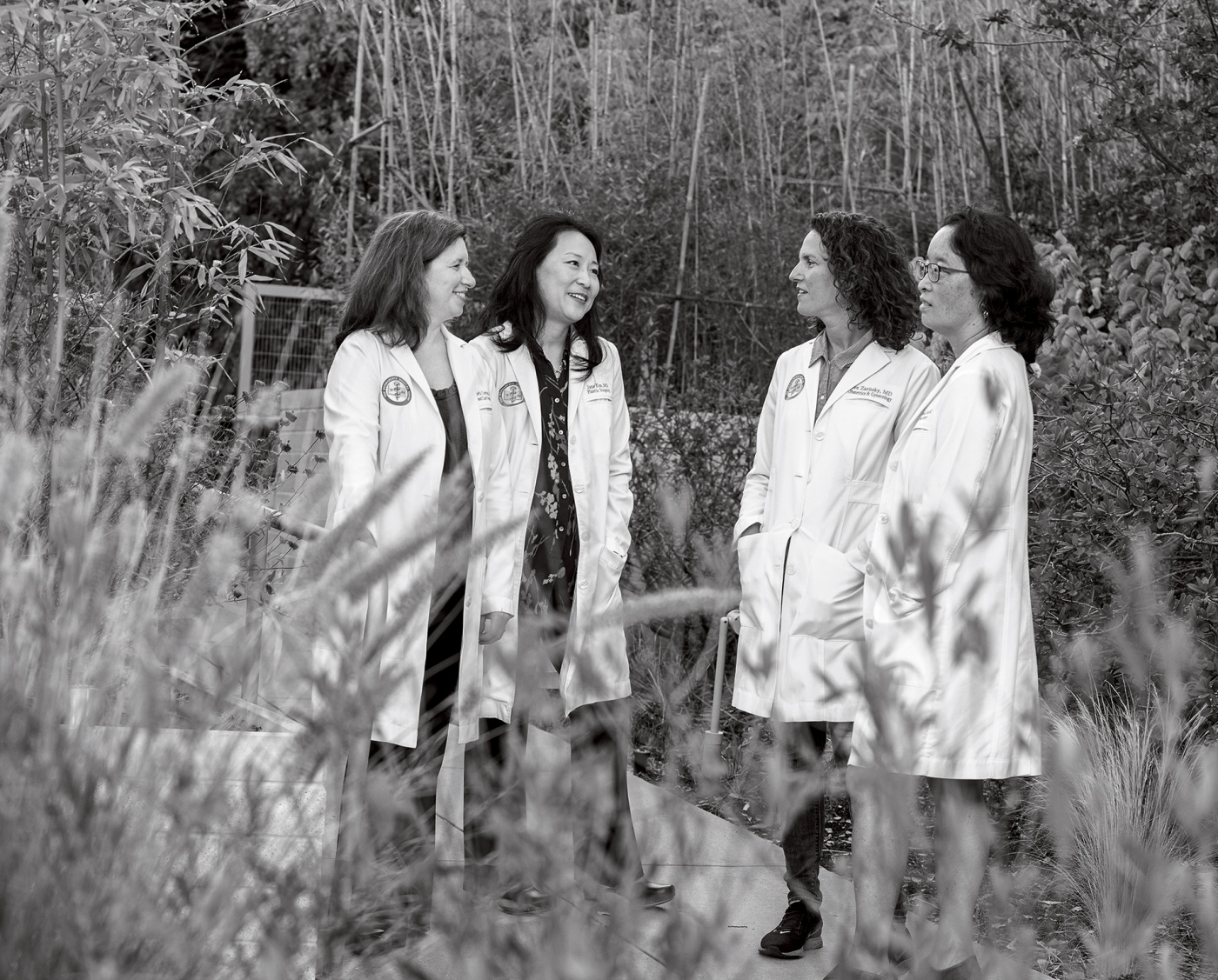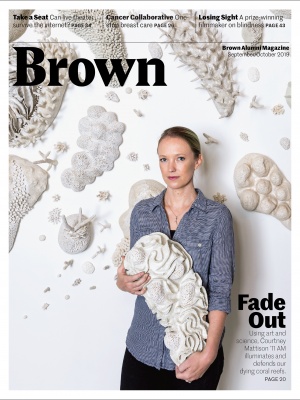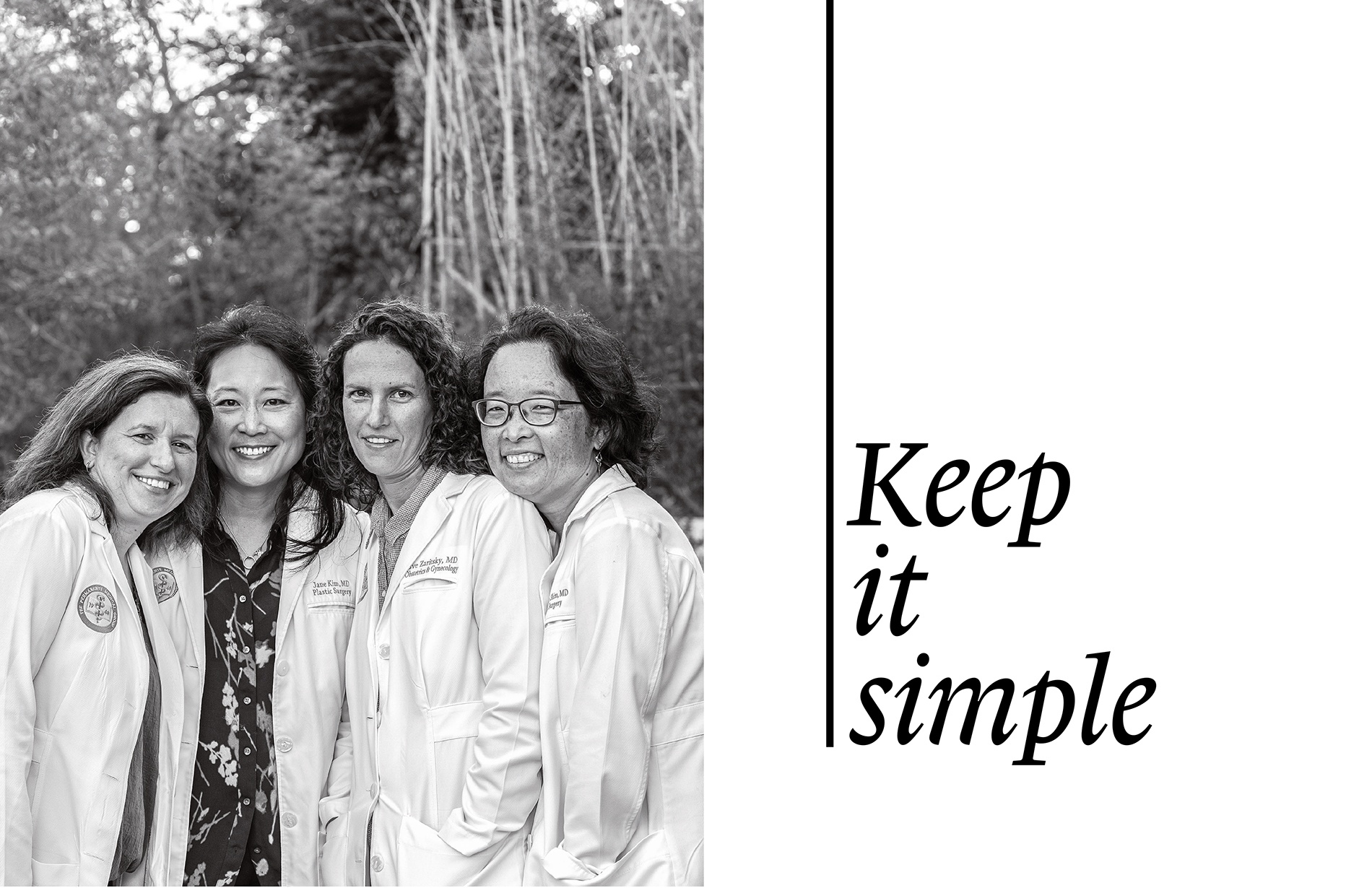
A breast cancer diagnosis is scary and can be complicated, requiring visits to multiple specialists. Four Brown alums—two cancer surgeons, a plastic surgeon, and a gynecologist—put multidisciplinary thinking into action with an integrated breast care center that lets the patient stay in one place.
Dr. Veronica Shim ’95 MD, a breast surgeon and oncologist, is feeling a little frantic. Two weeks before she meets with the BAM, her sister discovered a lump in her breast. She had a mammogram and ultrasound yesterday and Shim is anxiously awaiting the results. At age 49, Shim explains, her sister is at an age when a solid mass viewed on imaging “is cancer until proven otherwise.” Shim, dressed for late May in the San Francisco Bay Area in a hot pink midi dress with fashionable heavy black eyeglass frames, is particularly agitated because it took two weeks for her sister just to get the appointment—and will take another week for the biopsy. Exasperated, Shim told her sister: “God, if you were here, you’d have gotten a mammogram, ultrasound, and biopsy all in the same day!” She adds now: “If she wanted to, she could have seen a specialist here too, all in one package!”
In 2002, Shim founded the Kaiser Permanente Breast Care Center in downtown Oakland, California, to provide just this type of care: an integrated service provider giving patients a “one-stop shop” for all their breast cancer needs. Shim is the center’s director, and her team includes three fellow Brown alums: Dr. Elizabeth Cureton ’95, the center’s other dedicated breast cancer surgeon; Dr. Jane H. Kim ’92, a plastic surgeon who did her residency with Brown’s Alpert Medical School in 2003; and Dr. Eve Zaritsky ’95, an OB/GYN who is a part of the center’s Hereditary Risk Cancer Clinic, following up on the connection between breast and ovarian cancers for women with certain genetic profiles. As Zaritsky likes to explain: “They do the top half, I do the bottom.”
The care this team provides is part of a trend in coordinated care. Breast cancer treatment often requires patients to see surgeons, pathologists, primary care physicians, medical and radiation oncologists, and more. Traditionally, it has been the patient’s responsibility to identify providers, make appointments, and follow up on each doctor’s recommendation, often traveling to multiple facilities over extended periods of time while doing battle with insurance companies.
With coordinated care, the doctors share this burden with her. At the Breast Care Center, Shim and her team coordinate the treatment among themselves and most of the services are provided in one location. “The patient sits in an exam room and the doctors rotate through, providing her care,” Shim says.
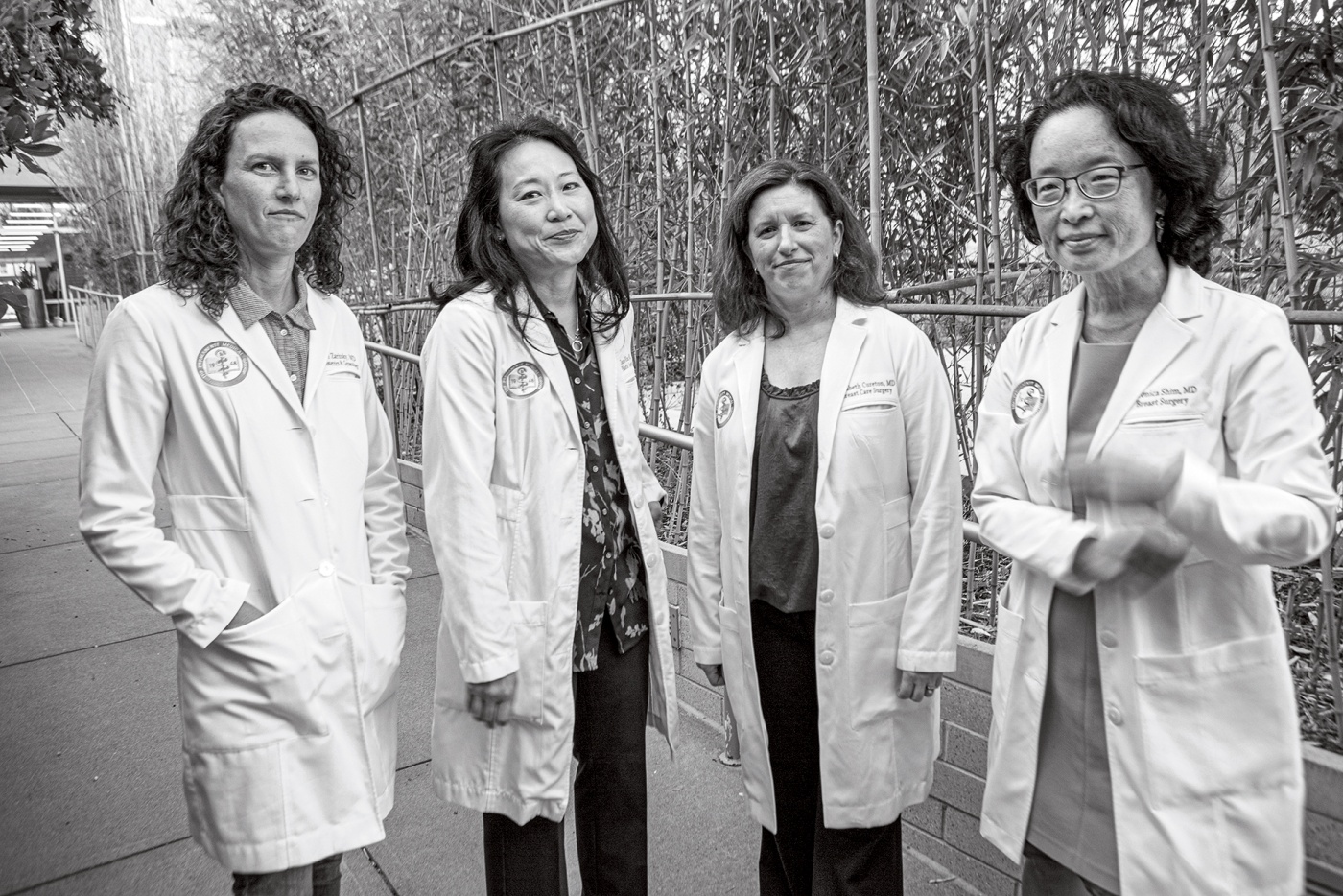
While all patients are unique, the doctors say, when they first arrive at the center they inevitably share one common trait: fear of death. Many know friends or family, particularly of an older generation, who died of breast cancer. For Dr. Shim, it was her aunt who died in the 1980s. Shim cites the loss as one of the events that influenced her decision to go into breast care. In 2017, more than 40,000 women died of breast cancer in the U.S., while 316,120 were newly diagnosed. Yet it is one of the great victories in the fight against cancer that over the last 30 years, the rate of women who survive breast cancer has risen by almost 40 percent.
“When I meet my breast cancer patients, what I love is the fact that they do well,” says Shim, who learned English at age 12 by watching soap operas on TV after emigrating from Seoul, Korea. She still speaks with a pronounced accent. “Most of them, their outcome is good. They will live a long time after the surgery,” Shim adds, drawing out her words for effect.
The Surgeons
Cureton wears a freshly pressed white lab coat with “Elizabeth Cureton, MD, Breast Care Surgery” embroidered in blue on her left chest. The decline in mortality from breast cancer has been attributed to both improvements in treatment and early detection. The vast majority—approximately 80 percent—of women in the U.S. who are diagnosed with breast cancer today will live, even though the incidence of breast cancer has actually increased since the 1970s. Most women who have breast cancer will have surgery. But she believes one of the most important advances has been learning that breast cancer is not just a surgical disease. Cureton, a soft-spoken woman with sincere brown eyes and an awkward smile, spends a good deal of her time outside of the operating room, discussing various treatment options with her patients. “Sometimes that means less treatment. Sometimes it means different and more precise treatment.” For example, trying chemotherapy rather than surgery, a lumpectomy (only cancerous tissue, plus a rim of normal tissue, is removed) instead of a mastectomy (removal of the entire breast) or the removal of one breast in which cancer has been identified instead of contralateral prophylactic mastectomy (the removal of a healthy breast when the other has cancer). When seeing patients at risk for developing breast cancer, she will discuss such preventative options as medication that blocks estrogen and lifestyle modifications such as weight loss.
As an undergraduate at Brown, Cureton worked with infants exposed to HIV at the Family AIDS Center for Treatment Support (FACTS) in Providence, and after graduation she worked at an HIV community center in Boston. It was while observing doctors treating the center’s members at a nearby hospital that Cureton—who briefly considered a career playing the oboe—decided on a career in medicine, wanting to take a hands-on approach to care with an eye to “big-picture prevention.” It is a sentiment repeated by each of the doctors, who view their roles as being as much a part of solving larger public health challenges as providing immediate patient care.
Cureton also emphasizes the importance of “increased surveillance” in breast cancer risk reduction. But a decade ago, the ability to perform such surveillance was undermined, as journalist Florence Williams reports in her award-winning 2012 book, Breasts: a Natural and Unnatural History—by the 2009 U.S. Preventive Services Task Force. Best known for its recommendations to defer and lessen the use of mammograms, the Task Force also recommended that doctors no longer perform breast exams during annual check-ups, nor teach women how to perform breast self-examination. “It’s a well-recognized fact that most breast cancers are found by women themselves, not by mammograms,” she writes. In an interview with the BAM, Williams explains the problem is not the exam, but rather that both women and doctors have been inadequately trained to perform them correctly and a healthcare system that fails to provide doctors with the necessary time to appropriately provide the service.
Dr. Shim also emphasizes that the most important advice she can give any woman is to know her own body. “Yes, you should get mammograms. But more than anything you need to be aware of your body,” she says. You also have to take the time to care for yourself. “That’s something that really hits me with my sister’s experience,” she laments. “My sister’s been busy, she’s a schoolteacher, she has a little kid and hasn’t thought about it….” Her voice trails off, then she recovers, stressing that if a woman feels that something is out of sync, she must be empowered to seek out expert care, and then take the time to utilize it.
The Plastic Surgeon
While the doctors stress the importance of nonsurgical solutions, in reality, most women with early-stage breast cancer will have surgery. Thus, after a patient sees Drs. Shim or Cureton, if they are likely to require a mastectomy, their next stop will be to visit Dr. Kim, the plastic surgeon. Kim starts by explaining the realities of breast reconstruction. “It’s a lengthy and often tough conversation,” she explains, and one that most patients do not fully absorb in the first sitting.
One could argue that Kim was born for the job—her father and both of her siblings are physicians. While still a junior in high school, Kim applied for Brown’s eight-year Program in Liberal Medical Education (PLME). Though, after four years at Brown, Kim went to Yale to complete medical school, she then returned to Brown for her residency, where she met her husband, who was also completing his residency at Brown.
It is one of the great victories in the fight against cancer that over the last 30 years, the rate of women who survive breast cancer has risen by almost 40 percent.
On this spring morning, Kim, dressed in green surgery scrubs, hair tied loosely behind her head and falling haphazardly about her face, lab coat pockets stuffed with notebooks and pens, takes a moment from her busy patient schedule to show off the props she uses to explain breast reconstruction. She holds up the light brown wicker basket full of jiggly clear silicone breast implants that sits on her desk as if it were a basket of apples, a big smile on her face. Two particularly large implants that have turned dirty brown with age prop open the door to the office.
The toughest part of her job, Kim says, is taming unrealistic expectations and addressing the many difficulties involved. That became somewhat more difficult in May 2013, when Angelina Jolie published a New York Times op-ed describing her decision to undergo a preventative double mastectomy and later an oophorectomy (the removal of ovaries). Jolie, who has a family history of breast and ovarian cancer, learned she had the BRCA1 gene, which sharply increases the risk of developing the diseases. Each of the doctors at the Breast Care Center interviewed here felt that Jolie’s decision to share her experience was extremely beneficial. A 2016 Harvard Medical School study supports their sentiments, finding that “The Angelina Jolie Effect” was a spike in genetic tests for breast cancer with no corresponding increase in mastectomies.
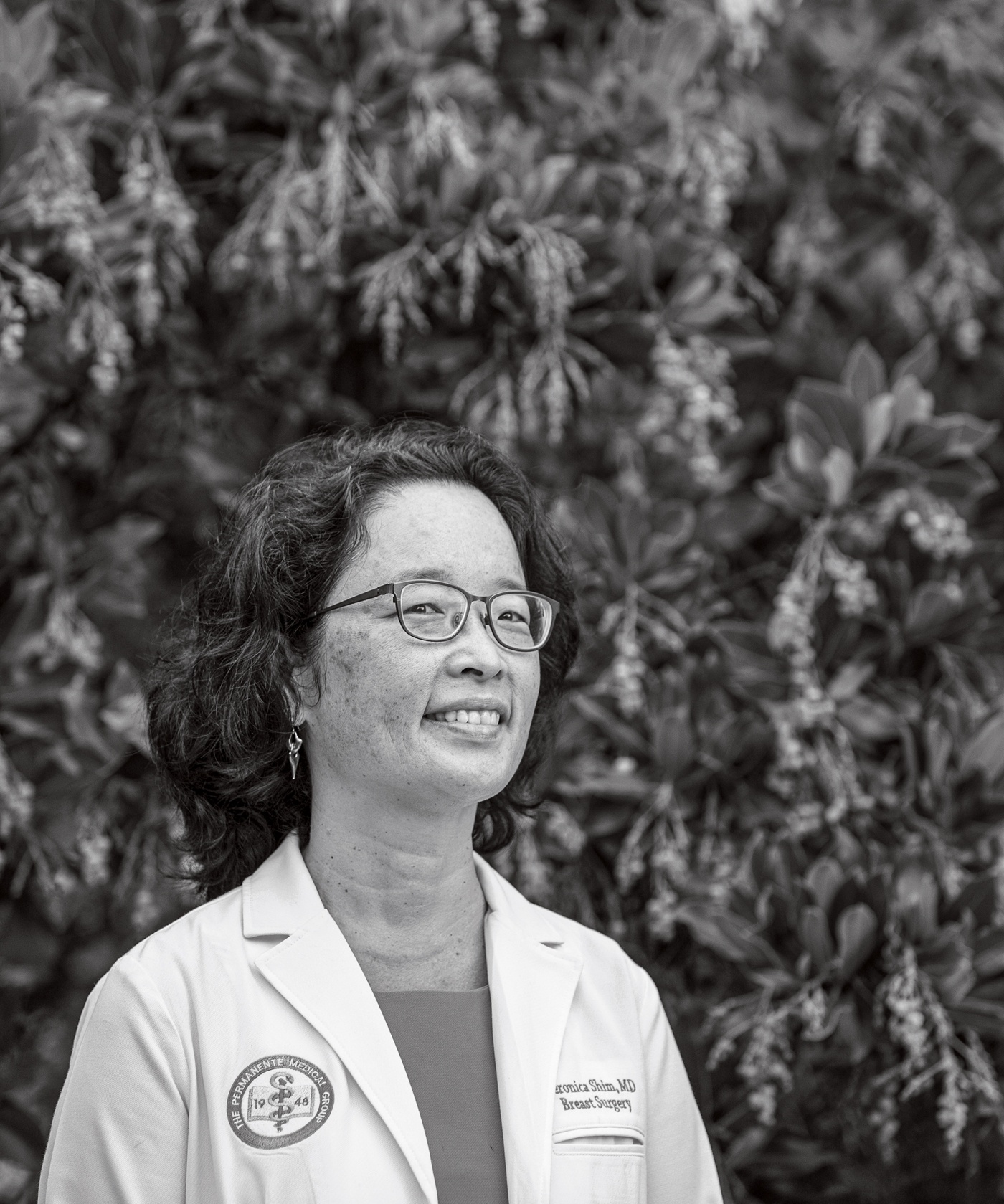
But plastic surgeons like Dr. Kim experienced an unexpected downside: patients who now expect to look like Jolie after reconstruction. “I’ve never seen Angelina Jolie’s breasts,” she quips, but she’s sure that looking like Jolie is not a realistic expectation for most patients. In addition to breaking this news, Kim must also explain that reconstruction usually involves multiple surgeries that can continue throughout a patient’s lifetime. When one breast has been reconstructed with an implant, for example, it will remain in stasis as the natural breast changes over time with weight loss or gain or simple aging, causing many women to undergo cosmetic surgeries in order to have “matching” breasts. There are also numerous potential complications that can arise at any point in a woman’s life after the initial surgery, including infection and the formation of thick scars around the implant requiring additional surgeries. Risk of complications is nearly twice as high for women who undergo mastectomy with reconstruction compared to a lumpectomy plus radiation. And for women with stage I or II breast cancer, the American Cancer Society finds an equivalent survival rate for those undergoing lumpectomy vs. mastectomy and even cites studies finding at times higher survivability with reduced recurrence. Nonetheless, the rate of women undergoing mastectomies increased 36 percent between 2005 and 2013, including a more than tripling of double mastectomies. Among the reasons cited are patients’ reluctance to undergo radiation therapy, fear of recurrence, distance from treatment centers, and the recommendation of surgeons, who in turn most often cite their desire to quell patients’ fears and avoid conflict.
Some women at the center will undergo not only mastectomy or a preventative double mastectomy, but also the removal of their ovaries, and often all at the same time. This is where Dr. Eve Zaritsky, the OB/GYN, comes in.
The Gynecologist
Zaritsky, who, with Shim, established the Hereditary Risk Cancer Clinic at the Breast Cancer Center through which all four women collaborate, exudes energy mixed with enthusiasm, with an extra dash of intensity. There are now six similar clinics at Kaisers across Northern California, Zaritsky says. She speaks rapidly, shifting from one topic to the next mid-sentence, mixing complex medical terminology with oftentimes hilarious colloquialisms. She doesn’t have time to waste. She’s on a mission to save women’s lives.
“So these BRCA patients, they have like a 20 to 40 percent chance of developing ovarian cancer,” she says. “So, Dr. Shim would see a patient with BRCA, and be like, ‘Okay, go over and see Eve in a couple of weeks to talk about your ovaries.’ And I was like, ‘This is stupid! Why don’t we have a clinic where these patients can come and we’re all there?!’”
So they started one. Over twice- monthly lunchtime meetings, the doctors sit with a geneticist who presents the patients with BRCA or the 150 or so similar rare gene mutations. They discuss their joint treatment plan for each patient, whom they will then see that afternoon, scheduling the appointments back-to-back at the Breast Cancer Center.
“Sometimes you can actually have all of your surgery at the same time, too,” Zaritsky says. “So, if you’re doing preventive surgery you can be like, ‘I want my boobs out and my ovaries out at the same time.’ And you’re done! So you don’t have to go weeks later to get your surgery at another time.”
It was this same enthusiasm that led Zaritsky to volunteer at Brown with a peer education program visiting group homes in Providence to teach about HIV/AIDS and safer sex, and to seek and receive a Brown Presidential Fellowship for Community Service grant to spend the summer of 1994 in the Philippines introducing a similar initiative there. It also drove her to move an initiative through Kaiser that increased the use of minimally invasive hysterectomies at Northern California Kaisers from less than 40 percent in 2008 to more than 93 percent in 2015, resulting, she tells me, in “significantly less pain, faster return to work, and shorter hospital stays” for thousands of patients every year.
More than 3.5 million women in the U.S. have a history of breast cancer. Most of these women will remain at risk for a recurrence and those who have undergone treatment will remain at risk for complications—indefinitely. The doctors at the Breast Care Center may therefore see their patients numerous times over decades and spanning a good deal of their lifetimes. Making this process easier and more efficient has a major impact.
All four alums feel the values of their practice have their roots at Brown. Cureton says she was constantly inspired by the commitment to social change that defined her fellow students at Brown, and that inspiration continues to inform her view of the world today. “Being around those students made me want to be a better person for the world,” she tells me, adding “I think there may be something of that in all of us, wanting to make a better world right here.”

